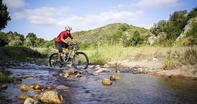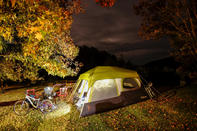Lovely Beyond the Telling
The 250-hectare indigenous forest at Grootvadersbosch Nature Reserve is thick with yellowwoods and stinkwoods. Forests such as this used to cover the Langeberg and the South-Western Cape, and Grootvadersbosch is the best example of what's left.

Bushbuck and Cape Grysbok are camouflaged amongst the tree trunks and almost 200 species of birds have been recorded. Take your bird and tree identification books and set off on one of the day trails.
At Grootvadersbosch, you walk down into the incised valley on an easy path, following the Duiwenhoks River for about three kilometres, and the 4x4 (vehicle) track narrows to a footpath, then ducks down a gully by way of natural rock steps… to the confluence of two tributaries and two connected pools, with their typically Coca-Cola hued water and little chance of seeing anyone else. The stream surges over small rapids between the long, narrow pools, lying in a deep gorge. It's lovely beyond the telling.
Duiwenhoks River

Not only is the campsite next to the Duiwenhoks River at Grootvadersbosch Nature Reserve one of the nicest in the Western Cape mountains, the stream below the camp is also one of the nicest for swimming, if you persist below the obvious small pool and find the very long ones in a small canyon at the end of the path that goes downstream through the forest.
It's worth the effort, even with children in tow. Take a picnic because you'll want to spend a few hours swimming, exploring and lying in the sun far from the hordes (which, with only 10 camping places, are never legion). There's also bird watching, forest-tree identification, hiking and mountain biking on offer.
 The sleepy Overberg farming community of Heidelberg, situated on the N2 in the shadows of the majestic Langeberg Mountains, serves as your m...
The sleepy Overberg farming community of Heidelberg, situated on the N2 in the shadows of the majestic Langeberg Mountains, serves as your m...